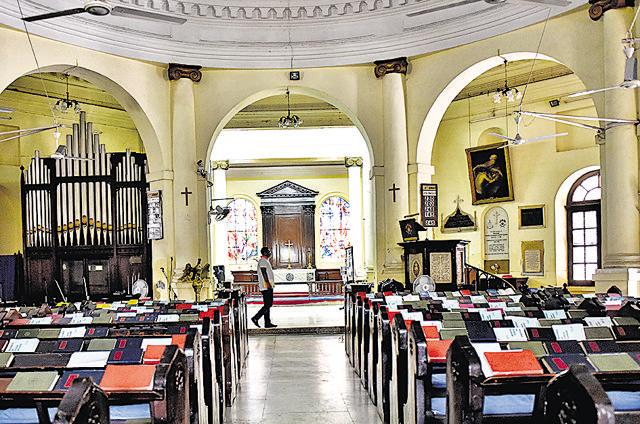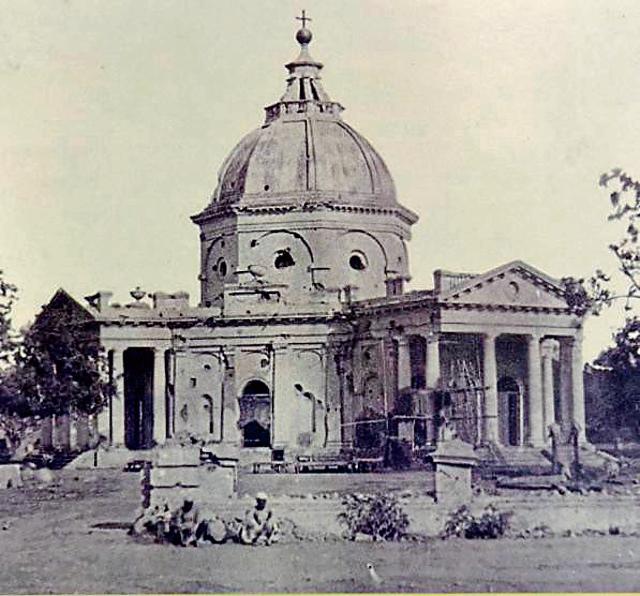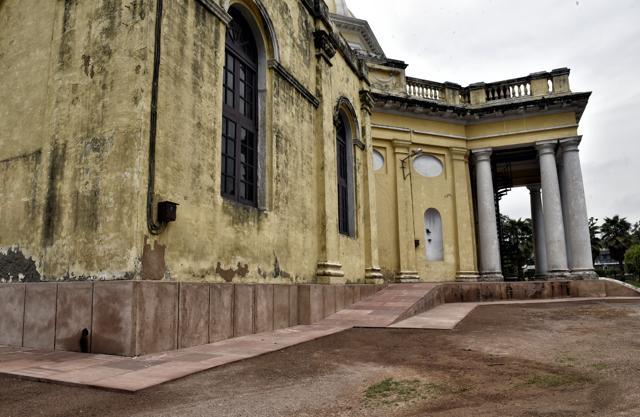At Kashmere Gate, a 180-year-old church waits for a miracle
The construction was started sometime in 1821 and consecrated 15 years later, which means that the first Bishop service was held in 1836.
One of the oldest churches of the city, St James, Kashmere Gate, is on the verge of degeneration and has been crying for repair.

The first phase of repair of the 181-year-old structure was recently completed, but the Church Conservation Committee has been running short of funds, making it impossible for it to continue the remaining work.
The church, which saw its first bishop service in 1836, has been surviving with severe damage to its foundation and its structures on the verge of crumbling.
In April last year, the church conservation committee, with the help of Indian National Trust for Art and Cultural Heritage (INTACH), had launched restoration work on the grand old structure. A grade I heritage structure notified by the Delhi government, the total cost of conservation was estimated to be around Rs 3.5 crore.
A severely fund-starved church committee has now planned a fund raising event on July 29 to invite individuals, social and government organisations along with corporates to make contributions through their CSR initiatives.
“The church is a live monument and attracts tourists and students from across the globe. It is a heritage structure closely wedded with the history of the city for the past two centuries. We must preserve it. Therefore, we are appealing to organisations, people and especially the corporates, to come forward and help us under their CSR initiative,” says Kamal Baluja, chairman, Church Conservation Committee.
History of its construction

On a sunny afternoon in January in 1800, Colonel James Skinner, who was fighting for Karoli’s (now in Haryana) ruler against the king of Uniara, was lying injured with several others in the battlefield near Tonk in Rajasthan.
Tortured by the heat, the injured were crying for water. Jackals were feasting on the dead, ignoring the feeble attempts by the wounded soldiers to shoo them away. It was then that Skinner made a vow to build a church if he survived.
And his prayer was answered the next morning. An old woman reached the site with a basket full of bread and a pot of water for the troops and they survived
But it took Skinner almost 20 years before he could fulfil his vow.
He started building St James’ Church just opposite to his mansion near Kashmere Gate, north Delhi, in 1821. The construction was started sometime in 1821 and consecrated 15 years later, which means that the first Bishop service was held in 1836.
The initial budget of construction was estimated at Rs 95,000 which escalated to around Rs 2 lakh later.
Glorious past

Skinner, an Anglo-Indian military adventurer, was born to a Scottish father (an officer in East India Company Army) and a Hindu Rajput princess mother in Kolkata in 1778. He was raised as a Muslim and joined the Maratha army as a mercenary only to later join the British forces. Before shifting his residence to Kashmere Gate, Skinner stayed at Kucha Raiman (now known as Kucha Rehman) in Chandni Chowk, where he had built a house in 1811 after settling down in Delhi.
“Skinner’s decision to move to this part of the city (Kashmere Gate) was prompted by his attempt to fit into the British society. It was during its consecration that Skinner and his three sons were confirmed in their Christian faith,” INTACH Delhi chapter’s convener Swapna Liddle writes in her book ‘Chandni Chowk: The Mughal city of old Delhi’.
In its history of 180 years, St. James’ Church has witnessed several momentous events. This is the place where two notable citizens of Delhi — Master Ram Chander and Chiman Lal were baptised in July 1852. Chander was a Mathematics teacher at a government college and Lal was working as a government sub-assistant surgeon.
Queen Elizabeth and Prince Philip, duke of Edinburgh also worshipped here in 1961.
The church almost turned to ruins during the mutiny in 1857. The mutineers shot down its gilt cross and the bell. The structure was attacked with cannons, rendering its walls badly mutilated.
Status of semi-official church
St James’ Church also served as a semi official church during the British empire where viceroys worshipped. It was designated as the semi-official church of the government and of the Army headquarters after Delhi achieved its status as Capital of British India in 1911.
“Until the shifting of the British Capital to New Delhi, St James’ Church was mostly frequented by the East India Company officers and Christians living in Delhi. When, the British took over the city after the mutiny, it assumed significance and the number of worshippers increased,” said Satish Jacob, a veteran journalist.
However, this glory was short-lived. It was considered by the British government that this modest church would not suffice for imperial purposes. Hence, its semi-official status ceased in 1931 and the Church of Redemption (near Rashtrapati Bhavan in North Avenue) was conferred the semi-official title instead.
“Still, there are about 200 members on the church’s roll and worship takes place every Sunday, in which around 100 odd people participate. The number is higher on occasions like Christmas,” says Baluja.
Restoration and challenges

At present, the restoration of the church is faced with one major challenge. Two underground tracks of Delhi Metro’s Heritage line (connecting Mandi House and Kashmere Gate station), passes through the church’s compound and are just five metres away from the building.
Ajay Kumar, project director, INTACH Delhi chapter, said the exact amount of damage to the foundation of the church due to vibrations caused by Metro rail movement is not known but the work to stabilise the underpinning has successfully been completed.
“Due to concentrated water seepage, the plinth protection was damaged. During the rains, the ground water level increases exceptionally in the area and water gets into the foundations. Leakages in the roof are also damaging the structure. Under the first phase, safety measures to prevent possible damage to its foundation has been taken,” he adds.
Stay updated with all top Cities including, Bengaluru, Delhi, Mumbai and more across India. Stay informed on the latest happenings in World News along with Delhi Election 2025 and Delhi Election Result 2025 Live, New Delhi Election Result Live, Kalkaji Election Result Live at Hindustan Times.
Stay updated with all top Cities including, Bengaluru, Delhi, Mumbai and more across India. Stay informed on the latest happenings in World News along with Delhi Election 2025 and Delhi Election Result 2025 Live, New Delhi Election Result Live, Kalkaji Election Result Live at Hindustan Times.





